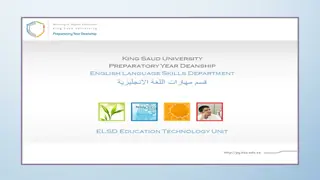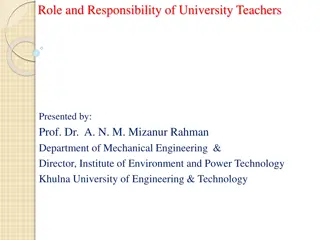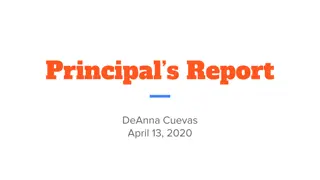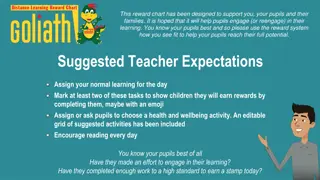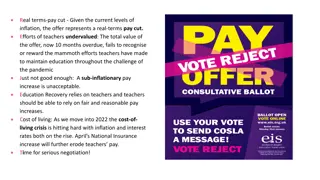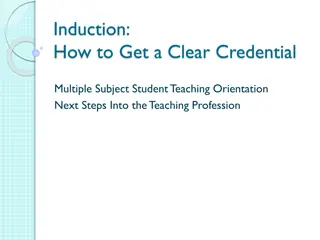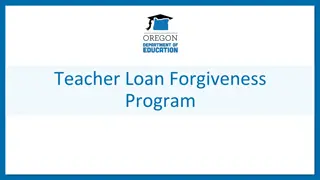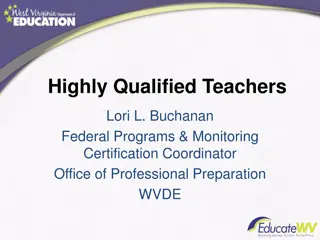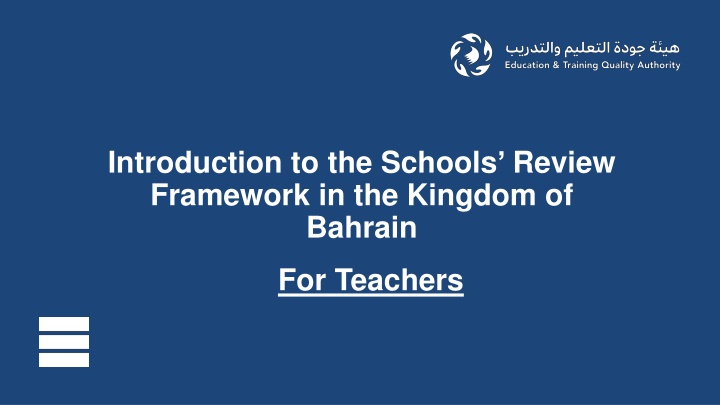
Enhancing School Performance: Bahrain's New Framework Explained
Learn about the updated Schools Review Framework in Bahrain, designed to meet local needs and strategic objectives. Explore the different aspects of the framework, including student academic standards, well-being, teaching strategies, leadership effectiveness, and more. Discover how teachers can improve classroom practices and procedures through indicators like active learning, authentic assessment, and constructive feedback.
Download Presentation

Please find below an Image/Link to download the presentation.
The content on the website is provided AS IS for your information and personal use only. It may not be sold, licensed, or shared on other websites without obtaining consent from the author. If you encounter any issues during the download, it is possible that the publisher has removed the file from their server.
You are allowed to download the files provided on this website for personal or commercial use, subject to the condition that they are used lawfully. All files are the property of their respective owners.
The content on the website is provided AS IS for your information and personal use only. It may not be sold, licensed, or shared on other websites without obtaining consent from the author.
E N D
Presentation Transcript
Introduction to the Schools Review Framework in the Kingdom of Bahrain For Teachers
Why has the Schools Review Framework been changed? To Meet the local need and achieve the strategic objectives of the Education and Training Quality Authority (BQA) through: Refocus and encourage development efforts 1. Refocusing and encouraging development efforts 2. Raising Schools Performance in the Kingdom of Bahrain 3. Increasing cooperation and partnership between BQA & Schools 4. Increasing the efficiency of BQA operations
Starter for Discussion How many aspects are there in the new Framework? Which aspect has been merged with others? Have new criteria been added to the new Framework aspects?
General Framework for School Performance Review Aspect (1) 1.1 Students Academic standards Students Academic Achievement 1.2 Students' Progress and Learning Skills Aspect (2) 2.1 Students well-being and sense of belonging Personal Development and Well-being 2.2 Students Behaviour Aspect (3) 3.1 Use of Effective Teaching and Learning Strategies Teaching, Learning and Assessment 3.2 Assessment and Academic Support 4.1 Leadership Effectiveness and Continuous Improvement Aspect (4) 4.2 Staff Development and Support Leadership, Management and Governance 4.3 Resilience and Innovation 4.4 Governance, Parental and Stakeholders Involvement in School Life Overall Effectiveness
Teaching, Learning and Assessment aspect Where to obtain data and Indicator Criteria evidence? Managing conducive learning environment Educational and technologic al resources Classroom management 3.1 Use of Effective Teaching and Learning Strategies Active learning Teaching, Learning and Assessment Technology and resources utilisation Lesson plans Assessmen t policy Students work Assessme nt structure Feedback to students Authentic assessment 3.2 Assessment and Academic Support Differentiation and challenge Students participati on School records Meetings Constructive feedback Effectiveness of academic support programs Learning situations Surveys Academic support
Training activity on reviews aspects Activity (1): Discuss with your group members the indicators of Teaching, Learning and Assessment Criteria in the diagram below, to answer the following questions 1 Write criteria A and B? Criteria B Criteria A 2 What is meant by the "active learning" indicator in Criterion A? Authentic Active learning assessment 3 How does constructive feedback affect student progress and learning over time? Managing a productive learning environment Feedback How does the teacher benefit from the indicators of: managing a conducive learning environment, and authentic assessment, in improving the effectiveness of classroom practices and procedures? 4 What are the teacher's proposed roles to improve the quality of evaluating the criteria of: student inclusion and well-being, and academic standards? 5
Stages and procedures of the review After Review Before Review review Stage 3 Stage 1 Stage 2
Review Stages and Procedures Stage 2 Stage 3 Post review Stage 1 Pre-review During the review 3-5 days depending on school size 5 weeks post review 2 weeks pre-review Lesson observation Meeting with school staff, parents and students Scrutiny of sample tests and exams Observation of students behaviour analysis of school data and documents Scrutiny of students electronic and written work Inspection of students safety and security measures according to the Child Protection Protocol Iinspection of school s resources and premises utilisation Provide daily feedback Holding team meetings Provide final feedback The Directorate concerned sends a copy of the draft report to school for factual accuracy School comments- if any- taken into consideration in 3 Working days after receiving the Draft Report . School informed about review date. 1 week pre- review 4 weeks after receiving the draft report Lead visits the school to discuss review plan and its requirements The school submits an action plan implementing the recommendations. Quality assurance manager visits the school to ensure the quality of review procedures
Aspects of focus in lessons Activity (2): What are the most important aspects that teachers should focus on or avoid to ensure the effectiveness of lessons? Don t Do
Aspects of focus in lessons Ensure that learning takes place with effective assessment methods Planning according to the depth of competencies Focus on procedures without effectiveness Focus on a specific group of students Focus on quantity without quality and depth Effectively manage lessons Random transition between activities Focus on added value Don t Do Utilise the results of assessment to support students Moving Implement effective strategies and resources Lowering expectations in the content provided between lesson activities without effective evaluation
Features of an Outstanding Lesson Activity (3): What are the features of an outstanding lesson? Features of Outstanding lesson
Features of an Outstanding Lesson Students are engaged in effective strategies and resources Students are responsible and work independently Features of an Outstanding Lesson Students show evident progress in acquiring knowledge and skills Students learn in a productive classroom environment Students are competitive and innovative Students participate effectively and assume leadership roles Students are given differentiated and challenging tasks Students are assessed effectively
Teaching, Learning and Assessment aspect will be judged on a four-point scale as follows
For more information, kindly visit the below platforms of the Education and Training Quality Authority





